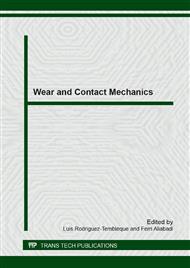[1]
L. Baroumes, E. Bouillon, F. Christin: An improved long life duration ceramic matrix composite material for jet aircraft engine applications, 24th International Congress of the Aeronautical Sciences, (2004).
Google Scholar
[2]
H. Esfandiar, S. Daneshmand, M. Mondali: Int. J. Advanced Design and Manufacturing Technology, Vol. 5/ No. 1, (2011).
Google Scholar
[3]
S. Itou: International Journal of Fracture, Volume 103 Issue 3 (2000), pp.279-291.
Google Scholar
[4]
W. Thompson, (Lord Kelvin): Cambridge and Dublin Math. J., 3, (1848), p.87–89.
Google Scholar
[5]
G. Green: An essay on the application of mathematical analysis to the theories of electricity and magnetism, (Nottingham, England: T. Wheelhouse, (1828), pp.10-12.
Google Scholar
[6]
G. Lamé: Leçons sur la théorie mathématique de l'élasticité des corps solides, (1852).
Google Scholar
[7]
J. Boussinesq: Application des potentiels a l'e´tude de l'e´quilibre et du mouvement des solides e´lastiques, Gauthier-Villars, (1885).
Google Scholar
[8]
H. Hertz: J. Reine Angew. Math. 92, (1882) p.156–171 (in German).
Google Scholar
[9]
V. Cerruti, In: A.E.H. Love (ed.), A Treatise on the mathematical theory of elasticity, fourth ed., Dover Publications, New York, (1882).
Google Scholar
[10]
R.V. Southwell: Phil. Mag., Ser. 7,1, (1926) p.71.
Google Scholar
[11]
R.D. Mindlin: Journal of Applied Physics 79, (1936) p.195–202.
Google Scholar
[12]
J.R. Barber and M. Ciavarella: International Journal of Solids and Structures, Vol.37, (2000), pp.29-43.
Google Scholar
[13]
N.L. Muskhelishvili: Singular integral equations, P. Noordhoff Ltd., Groningen, The Netherlands, 1953. (based on the second Russian edition published in 1946).
Google Scholar
[14]
A.H. England: Complex variable methods in elasticity, Wiley Interscience, London, 1971.
Google Scholar
[15]
K.L. Johnson: Contact Mechanics, Cambridge University Press, 1987.
Google Scholar
[16]
F. Erdoga:, Mixed boundary value problems in mechanics in: Nemat-Nasser, S. (ed.), Mechanics Today 4. Pergamon Press, (1978) p.1–86.
Google Scholar
[17]
F. Erdogan: SIAM J. Appl. Math. 17, (1969), p.1041–59.
Google Scholar
[18]
A. Stroh: Philos. Mag., 3(30), (1958) p.625–646.
Google Scholar
[19]
A. Stroh: J. Math. Phys., 41(2), (1962), p.77–103.
Google Scholar
[20]
S.G. Lekhnitskii, Theory of elasticity of an anisotropic elastic body, Holden-Day, San Francisco 1963.
Google Scholar
[21]
V.A. Sveklo: J. Appl. Math. Mech. 28, (1964) p.1099–1105.
Google Scholar
[22]
J.R. Willis: J. Mech. Phys. Solids 14, (1966) p.163–176.
Google Scholar
[23]
A.A. Shi, Y. Lin, T.C. Ovaert: J. Tribol. 125, (2003) p.223–231.
Google Scholar
[24]
V. Kahya, A. Birinci and R. Erdol: International Journal of Computational and Mathematical Sciences, (2007), 1, 121–127.
Google Scholar
[25]
R. Batra, R and W. Jian: Int. J. Solids Struct., 45(22), (2008), p.5814–5830
Google Scholar
[26]
C. Bagault, D. Nelias, and M.C. Baietto: Journal of Tribology 134 (3), (2012) 031401-1–031401-8.
Google Scholar
[27]
H. Ashrafi, M. Mahzoon and M.Shariyat: Iranian Journal of Materials Science and Engineering, (2012), 9(1): 29-41.
Google Scholar
[28]
X.-Q. Dong, Y.-T. Zhou, L.-M. Wang, S.-H. Ding, J.-B. Park: Arch Appl. Mech.(2014)
Google Scholar
[29]
G. Ramirez, P. Heyliger: Smart Mater. Struct. 12, (2003) p.612–625.
Google Scholar
[30]
G. Ramirez: Journal of Smart Materials and Structures, Vol. 15 No 5, (2006) pp.1287-1295.
Google Scholar
[31]
Y.T. Zhou, K.Y. Lee: Philosophical Magazine Vol. 92 No. 15, (2012) p.1937–1965.
Google Scholar
[32]
Y.T. Zhou, K.Y. Lee: Arch Appl. Mech. 83, (2013) p.73–95.
Google Scholar
[33]
S. Krenk: Journal of Composite Materials, 13, (1979) pp.108-116.
Google Scholar
[34]
A. Cinar, F. Erdogan: International Journal of Fracture, (1982) p.83–102.
Google Scholar
[35]
M. Ozturk, F. Erdogan: International Journal of Engineering, Sci.Vol.35. No. 9, (1997) pp.869-883.
Google Scholar
[36]
M. Ozturk, F. Erdogan: International Journal of Fracture, 98, (1999) p.243–261.
Google Scholar
[37]
M.A. Guler: Contact stresses in an orthotropic medium: a closed-form solution, submitted to journal (2014).
Google Scholar
[38]
M. A. Guler, F. Erdogan: International Journal of Solids and Structures, Vol. 41, (2004), p.3865–3889.
Google Scholar
[39]
M. A. Guler, F. Erdogan: Mechanics of Materials, Vol. 38, (2006), p.633–647.
Google Scholar
[40]
M. A. Guler, F. Erdogan: International Journal of Mechanical Sciences, Vol. 49, No. 2, (2007), p.161–182.
Google Scholar
[41]
I. Bakırtaş: International Journal of Engineering Science, Vol. 22, No. 4, (1984), pp.347-359.
Google Scholar
[42]
F. Erdogan: Fracture materials and contact problems in materials involving graded coatings and interfacial zones, Final Technical Reports, Lehigh University, (2001).
DOI: 10.21236/ada387409
Google Scholar
[43]
Y.T. Chou: Journal of Applied Physics 33, (1962) p.2747–2751.
Google Scholar
[44]
F. Erdogan and G. D. Gupta: Quarterly of Applied Mathematics Vol. 29 (1972) pp.525-534.
Google Scholar
[45]
F. Erdogan, G. D. Gupta and T. S. Cook: Numerical solution of singular integral equations, Method of Analysis and Solution of Crack Problems, G.C. Sixth (ed.), Noordhoff, Int. Publ. Leyden, (1973) pp.368-425.
DOI: 10.1007/978-94-017-2260-5_7
Google Scholar


